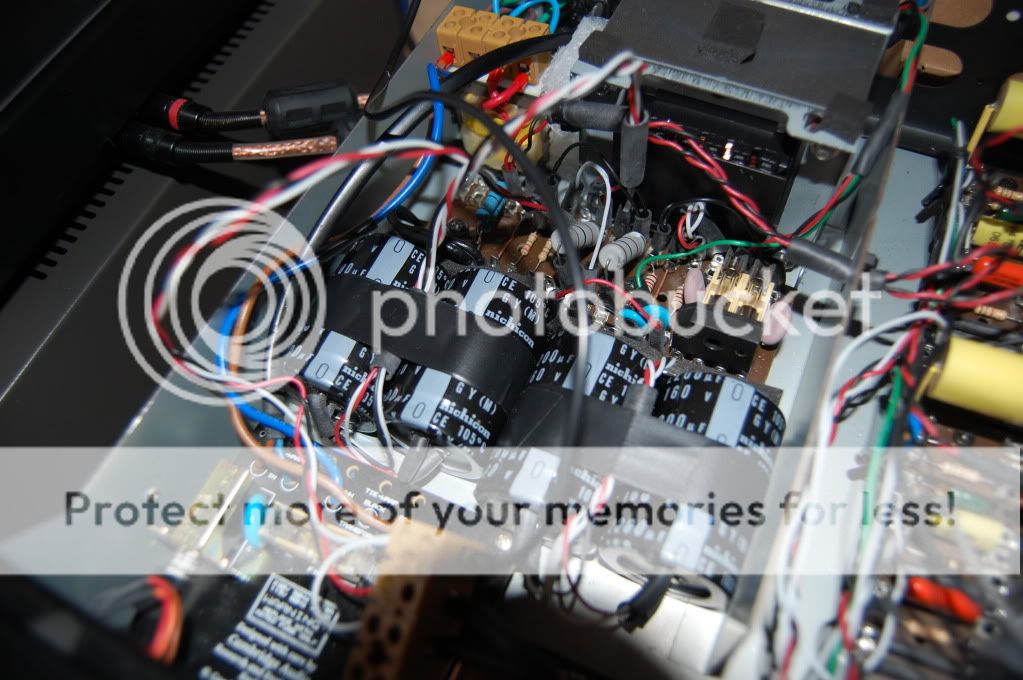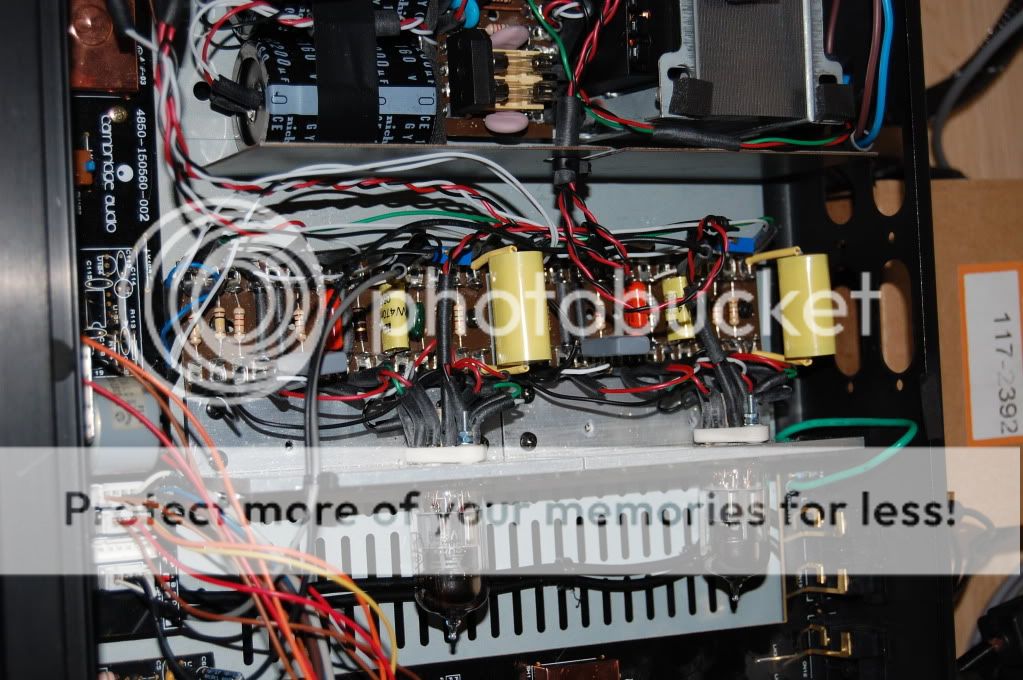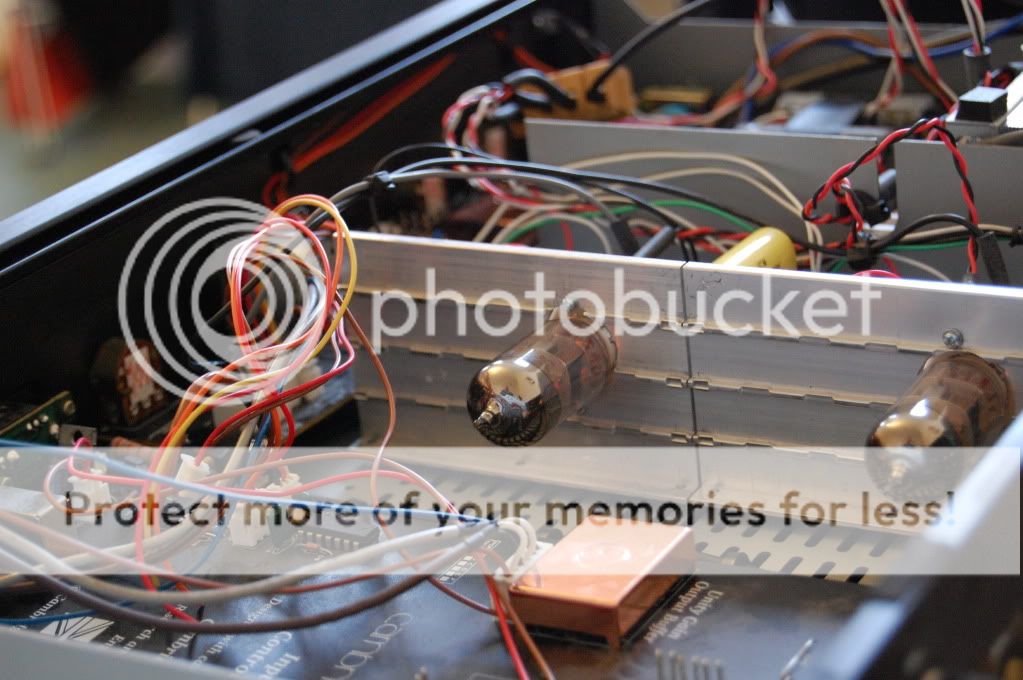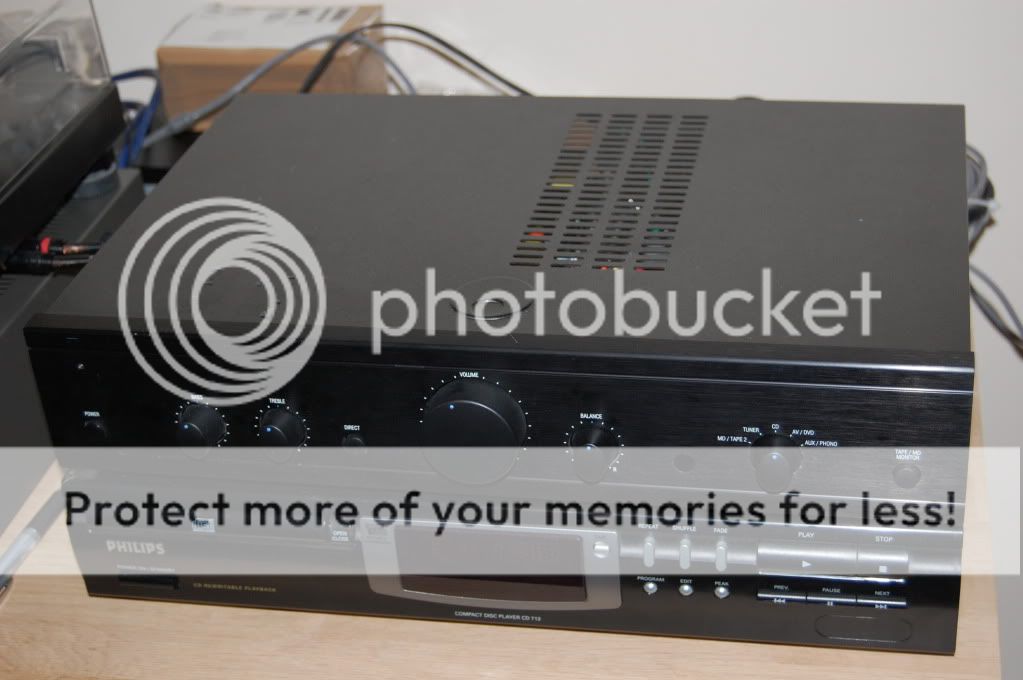I don't think so. Cold resistance is low and the part will never heat up. See if Maplin or Farnell has Epcos B57153S330Ms. That part is 33 Ω/25o, with an Imax. of 1.3 A. If you wrap a B57153S330M in wool or acrylic yarn and encapsulate in heatshrink, a reasonable temperature rise can be expected.
I all ready had them in when I read your response, I put one on each supply line and it seems to be working ok! dropping about 200mV accross them. I'll look for some more suitible parts soon.
Well I've got a working PSU now +/-74VDC rails and it's completly silent, I turned the volume all the way up with no source playing and it's completly silent all the way up; amazing.
I found a couple of big 2R2 resistors on an old SMPSU which I've used to bring the Heater voltage down to 6.15v.
Some pics: the Wiring still needs a tidy and the big caps need fastening down a bit better but it's about there now; a few mods Shoog sugested left to do and the BJT bootstrap to try.






Great news and a fine quality build (you should see my efforts - messy is not the word).
Are you still happy with the sound - how would you describe it compared to things your've heard before.
Having got my exams out of the way, I have dedicated a few days to progressing my latest project. After a few minor glitches (but no major explosions) I have it playing on the bench. Sounding Ok so far, Will attempt to scope it up to check. Great satisfaction bringing a project which has taken over a year of designing to this stage.
Shoog
Are you still happy with the sound - how would you describe it compared to things your've heard before.
Having got my exams out of the way, I have dedicated a few days to progressing my latest project. After a few minor glitches (but no major explosions) I have it playing on the bench. Sounding Ok so far, Will attempt to scope it up to check. Great satisfaction bringing a project which has taken over a year of designing to this stage.
Shoog
Great news and a fine quality build (you should see my efforts - messy is not the word).
Are you still happy with the sound - how would you describe it compared to things your've heard before.
Having got my exams out of the way, I have dedicated a few days to progressing my latest project. After a few minor glitches (but no major explosions) I have it playing on the bench. Sounding Ok so far, Will attempt to scope it up to check. Great satisfaction bringing a project which has taken over a year of designing to this stage.
Shoog
I'm usless at describing this sort of stuff but I'd have to say the bigest difference between this this and the SS stuff I'm used to is the sound seems to fill space rather than just comming out of the speakers and sounds really lively no hint of compression, I'm really happy with it! I still have to move the grid resistors like you said and source a new volume pot, the one fitted is a "soundwell". I suspect it dosen't!
The build is quite good, I used to repair Fibre optic comms kit, all tiny SMT and we couldn't use flux for various reasons; if you can solder components the size of a pin head without flux you can solder anything.
What is it your building this time and where's it for?
The presence and aliveness can be deceptive. If you experience listener fatigue after a few hours then there is high frequency has and the grid resistors would calm that down. If after an evenings listening you still want to carry on then its just good and has no serious issues.
My current build is the end of a long series of refinements of the Schade approach to plate to grid feedback. If it sounds as good as I think it will its destined for the main system. A stonking 7watts of Class A Push Pull power from a pair of 6080 bottles. I have effectively the same amp using 807 in the system at the moment - but I know that the 6080 can be one of the best sounding triodes available in PP. Will jury rig it to throw at the main system for tomorrow before attempting the remaining case work next week.
The problem with the hobby is that once you have successfully built one amp, you want to try new ideas and refinements to successes and the road never ends, If this amp and my current preamp (a version of the one you have built) work well together I think I will retire from building for the forseeable future - though I have said that before a few times.
Good luck on your first Power Amp build
Shoog
My current build is the end of a long series of refinements of the Schade approach to plate to grid feedback. If it sounds as good as I think it will its destined for the main system. A stonking 7watts of Class A Push Pull power from a pair of 6080 bottles. I have effectively the same amp using 807 in the system at the moment - but I know that the 6080 can be one of the best sounding triodes available in PP. Will jury rig it to throw at the main system for tomorrow before attempting the remaining case work next week.
The problem with the hobby is that once you have successfully built one amp, you want to try new ideas and refinements to successes and the road never ends, If this amp and my current preamp (a version of the one you have built) work well together I think I will retire from building for the forseeable future - though I have said that before a few times.
Good luck on your first Power Amp build
Shoog
Will jury rig it to throw at the main system for tomorrow before attempting the remaining case work next week.
Shoog
Thats the bit that always get's me with DIY, the Case, there dosent seem to be a source of decent barebones cases, that I can find anyway; What do you use? I always end up bodging stuff into cases designed into somthing else and it's never quite satisfying!
Please don't,,, I have so much non-audio stuff I'm ment to do.. That said I have a long list of solid state stuff I've been planning for a while; some of it may turn into a valve project; though I definitely fancy building one of the incredibly cheap 41HZ T-Amp Power amps; to drive the tweeters; see what TNT's going on about (JLTi)After the power amp comes the phono preamp build....
Fortunately I aquired a good range of 19inch case's from a college clear out. These are nice slim cases which have made good bases for my latest preamp and a headphone amp. For the big projects I bought, from a friend, some really nice large 19inch cases which have been good for the last three major builds. They all look nice if a little industrial.
I know what you mean about press ganging old cases into service, I started out that way, but they never quite work out well. I have a friend Fran who is a real craftsman when it comes to case work, he really puts my work to shame. To be honest if it isn't plain ugly I can live with it. I am far more interested in the circuit design than the end product. What is good now is I have lost the urgency to build which allows me to let a project evolve detail by detail.
Shoog
I know what you mean about press ganging old cases into service, I started out that way, but they never quite work out well. I have a friend Fran who is a real craftsman when it comes to case work, he really puts my work to shame. To be honest if it isn't plain ugly I can live with it. I am far more interested in the circuit design than the end product. What is good now is I have lost the urgency to build which allows me to let a project evolve detail by detail.
Shoog
I still have to move the grid resistors like you said and source a new volume pot, the one fitted is a "soundwell".
I don't know what can be readily sourced in the UK. If you can get Canadian made PEC controls, look no further. PEC hot molded Carbon controls are good sounding and reasonably priced.
I don't know what can be readily sourced in the UK. If you can get Canadian made PEC controls, look no further. PEC hot molded Carbon controls are good sounding and reasonably priced.
I will have a look; infact any-other recomendations for POTs welcome please.
Member
Joined 2009
Paid Member
In may ways it's simpler than SS work; It's getting out of the habit of prodding stuff when its turned on I find the hardest.
ALWAYS work with 1 hand in a pocket or wrapped around your belt in the small of your back. You've been working at voltages just above the danger minimum. You may get past a mistake, without injury. Make a mistake with the 480 or so V. in a KT88 amp and you are likely dead. Make a mistake at 1.2 KV., as used with 211s and 845s, and you will surely be dead.
The danger increases exponentially, as the rail voltage gets larger. Working with 1 hand, clip the ground lead in place. Then, still using 1 hand, take the necessary measurements.
I can tell you from personal experience, you will get "bit" and it hurts. The pain ends quickly enough, if you don't shock your heart. Shocked heart = dead builder.
Member
Joined 2009
Paid Member
I did once get stung, an old Heathkit from the charity shop back in the UK, I disconnected a metal connector on the back (it was held on with thumb screws, inviting somebody to fiddle) and when I came to put it back one of the terminals had floated up to an ungodly voltage. It was very clearly AC and although it wasn't very painful it was *very* powerful and a huge shocking surprise! The friend I was with had uncontrollable fits after seeing the expression on my face. I returned it to the charity store and never played with anything like it since.
10 Times 6DJ8 Amperex
Dear Allen,
I have read some of your notes concerning a valve preamp. I have 10 pcs. of 6DJ8/ECC88 Amperex valves and two Aikido printboards bought from Ebay. I would like to have a three stage circuit( the last stage as buffer) for a riaa where it is possible to use the ECC88 Amperex valves. I have bought a 100K stereo Alps pot for the project.
Besides the wish for a riaa circuit, I "sways" between the two line-Aikido boards and hardwiring.
Could you recommend and show me the "right" circuit for a line and riaa circuit for the mentioned valves, including best working voltage? Have allready a 220Vac powertransformer to regulate from.
Need the preamp to drive different power valveamplifiers.
Hobe you got the time for this?
Regards, Kim
Lars,
I and everyone who has built it, says the SLCF is a major advance over a plain CF as a output stage in a audio system.
But thanks for that patent - never seen it before.
I wrote up the SLCF for the TubePreamp CookBook as it worked for me. I got the idea (and never claimed otherwise) from Valley & Wallmann - although they never used both the CCs and the bootstrap in the same circuit.
>>The analysis I have seen is that the SLCF removes the feedback from the CF, turning the output tube into a diode with current gain. I would be interested in a critique of this idea.<<
Who the hell made that analysis? Sounds weird to me but would need to see the whole thing before I could comment accurately.
To me, the CCS keeps the pre-signal current constant, and the bootstrap keeps the anode/cathode voltage constant, so the only variation in the actual CF tube is the current changes into the load R from signal changes. All else stays as stable as possible.
And it IS a CF, as the cathode "follows" the grid - which fits the description pretty closely - no?
Regards, Allen
Dear Allen,
I have read some of your notes concerning a valve preamp. I have 10 pcs. of 6DJ8/ECC88 Amperex valves and two Aikido printboards bought from Ebay. I would like to have a three stage circuit( the last stage as buffer) for a riaa where it is possible to use the ECC88 Amperex valves. I have bought a 100K stereo Alps pot for the project.
Besides the wish for a riaa circuit, I "sways" between the two line-Aikido boards and hardwiring.
Could you recommend and show me the "right" circuit for a line and riaa circuit for the mentioned valves, including best working voltage? Have allready a 220Vac powertransformer to regulate from.
Need the preamp to drive different power valveamplifiers.
Hobe you got the time for this?
Regards, Kim
- Status
- This old topic is closed. If you want to reopen this topic, contact a moderator using the "Report Post" button.
- Home
- Amplifiers
- Tubes / Valves
- Low Voltage Tube Preamplifier